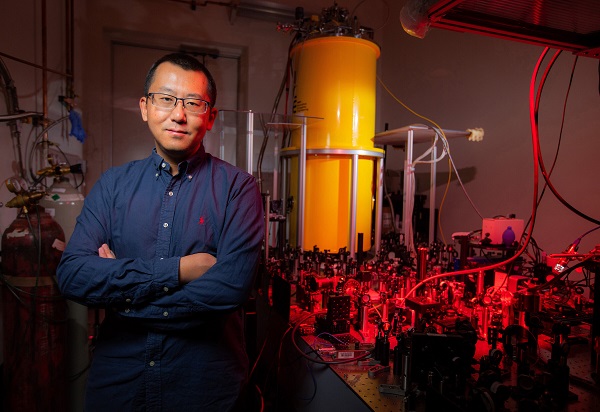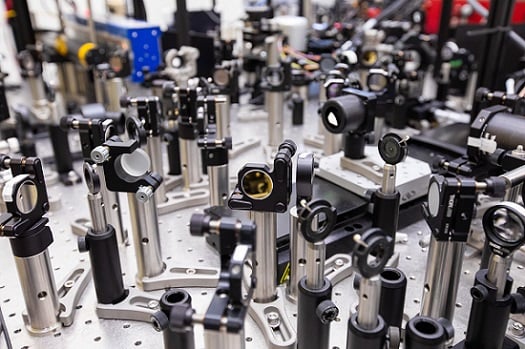A newly developed microscope housed at the U.S. Department of Energy’s Ames National Laboratory is poised to help researchers understand — and ultimately develop — the inner workings of quantum computing. The microscope, called a Cryogenic Magneto-Terahertz Scanning Near-Field Optical Microscope (cm-SNOM) by Iowa State University professor and Ames Lab senior scientist Jigang Wang, is based at Ames’ Sensitive Instrument Facility.
The device is composed of a laser source, a maze of mirrors creating an optical path for light pulsing at trillions of cycles per second, a superconducting magnet surrounding the sample space, a custom-made atomic force microscope, and a bright yellow cryostat that lowers sample temperatures down to the temperature of liquid helium, about −450 ºF.

Jigang Wang, a professor at Iowa State University and an Ames National Laboratory senior scientist, with the Cryogenic Magneto-Terahertz Scanning Near-Field Optical Microscope. The instrument works at extreme scales of space, time, and energy. Its performance is a step toward optimizing the superconducting quantum bits that will be at the heart of quantum computing. Courtesy of Christopher Gannon/Iowa State University.
The instrument took five years to build. It has been gathering data and contributing to experiments for less than a year.
According to Wang, the extreme-scale nanoscope is a world’s first.
The system provides focus down to about 20 nm while operating below liquid helium temperatures and in strong Tesla magnetic fields — small enough focus to get a read on the superconducting properties of materials in these extreme environments.
Supeconductors are materials that can conduct electricity without resistance or heat, generally at very cold temperatures. These materials are used in a variety of applications, including in medical devices such as MRI machines, as well as in quantum computers and magnetic racetracks for particle accelerators such as the Large Hadron Collider.
In quantum computing, superconducting quantum bits can be controlled using strong lightwave pulses.
“Superconducting technology is a major focus for quantum computing,” Wang said. “So, we need to understand and characterize superconductivity and how it’s controlled with light.”

A maze of mirrors on the cm-SNOM instrument creates an optical pathway for light pulsing at trillions of cycles per second. Courtesy of Christopher Gannon/Iowa State University.
Wang and a team of researchers are taking the first ensemble average measurements of supercurrent flow in iron-based superconductors at terahertz energy scales and the first cm-SNOM action to detect terahertz supercurrent tunneling in a high-temperature copper-based cuprate superconductor.
“This is a new way to measure the response of superconductivity under lightwave pulses,” Wang said. “We’re using our tools to offer a new view of this quantum state at nanometer-length scales during terahertz cycles.”
Ilias Perakis, professor and chair of physics at the University of Alabama at Birmingham and a collaborator on the project who has developed the theoretical understanding of light-controlled superconductivity, said, “By analyzing the new experimental data sets, we can develop advanced tomography methods for observing quantum entangled states in superconductors controlled by light.”
Still, the researchers said, the interactions able to drive these supercurrents remain poorly understood, partially due to the lack of measurements. Now that those measurements are happening at the ensemble level, Wang is looking ahead to the next steps to measure supercurrent existence using the cm-SNOM at simultaneous nanometer and terahertz scales. His group is searching for ways to make the new instrument even more precise.
“We really need to measure down to that level to impact the optimization of qubits for quantum computers,” Wang said. “That’s a big goal. And this is now only a small step in that direction. It’s one step at a time.”
The research regarding quantum coherence tomography of light-controlled superconductivity was published in Nature Physics (www.doi.org/10.1038/s41567-022-01827-1). The work regarding cm-SNOM is awaiting publication and currently available in preprint form on arXiv (www.doi.org/10.48550/arxiv.2210.07319).